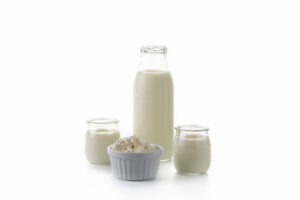
the gold standard
According to infant formula statistics, only 40% infants are breastfed worldwide, some countries have percentages as low as 10%. (2005)
Human milk (HM) contains a unique blend of proteins that provides energy, essential amino acids, and a variety of bio-activities that support healthy growth and development during early infancy. Breastfeeding reduces the risk of chronic diseases later in life. For this reason, HM is considered the gold standard of early infant nutrition and the World Health Organization (WHO) recommends that infants be exclusively breastfed for the first six months of life. Exclusive breastfeeding in the population of infants under six months averages only 40% worldwide.
This is the highest risk factor for chronic conditions.
The influence of natural feeding on human health
Breastfeeding is the most appropriate way to nourish infants. It promotes proper physical and intellectual development of the child. Human milk is unique and impossible to replicate with any other kind of food. Breastfeeding improves immunity and decreases the occurrence of infections, especially those of the gastrointestinal tract and respiratory tract. It also helps to reduce the risk of some disorders such as allergies, diabetes mellitus type 1, obesity and arterial hypertension. The start and end times of breastfeeding are fundamental. Each of the organs or systems of the human body are characterized by a critical period as a time of intensive development. Harmful factors such as malnutrition, can lead to irreversible morphology and functional damages. Mother’s milk is the most suitable food for the child. It consists of components suitable for building immature gastrointestinal mucosa, the central nervous system, endocrine system and immune system, and determines the proper development of other systems. Human milk contains essential vitamins, minerals and other important components, such as nucleotides and DNA, which are not present in any artificial milk. The composition of breast milk is not constant and depends on the nutritional status of the mother. Human milk is species-specific and adjusts its composition to the developmental needs of the infant.
Improving infant formula since the 1840’s The first baby bottle was patented in 1841. Many previous nutrition studies identified health disparities between breastfed and non breast fed infants. Despite nutritional studies in formula fed vs. breastfed infants since then, especially in premature infants, various and numerous fortification efforts during this crucial infant development period have failed to rescue and reverse the chronic malnourishment status that is associated with not breast feeding and adverse health outcomes later in life. Researchers found that malnourished children’s microbiota failed to follow the healthy pattern they identified in healthy children. Dr. Jeffrey Gordon’s work suggests the microbiota of malnourished children is immature, lagging in development behind that of their healthy peers. Supplementing these children’s meals with widely used therapeutic foods that increase calories and nutrient density reduces deaths from malnutrition, but it does not fix their persistent microbiota immaturity. “Perhaps more insidious than slowing growth is malnutrition’s effect on less visible aspects of health, including impaired brain development and dysfunctional immunity, which follow these children throughout their lives”.
Jeffrey I. Gordon, MD “The father of the microbiome”
The WHO has established some clear guidelines outlining current status, addressing chronic malnutrition problems, intestinal diarrheal disease prevention and later prevention of chronic disease. Researchers are quickly working to develop clinical advancement of these goals and together this may quickly establish a solid foundation for the future of tomorrow’s children.
date nut muffins
Date Nut Muffins are a classic British teatime treat made with sweet dates and toasted walnuts.
Date nut muffins are a handy variation on date nut bread, which originated in Great Britain (specifically Scotland) as a tea time treat. This recipe uses a small amount of brown sugar.
did you know?
Bifido Longum is the champion colonizer of the infant gut
The immunoglobulins, or antibodies, found in colostrum or milk are the same as those found in the blood or mucosal secretions. They are a family of proteins with a range of protective bioactivities. Immunoglobulins are divided into several classes including IgM, IgA, IgG, IgE, and IgD, and IgG, IgA and IgM are the major immunoglobulin classes in mammary secretions. IgM is the class that appears initially when an organism is exposed to an antigen for the first time (primary infection). IgM has a low specificity and hence a lower potency in defeating the infection. IgA is the major immunoglobulin class found in mucosal secretions and prevents mucosal infections by agglutinating microbes, whereas IgG is the primary immunoglobulin class found in bovine colostrum and milk. Several subclasses of IgG exist, with IgG1 and IgG2 being the major immunoglobulins in serum.
SAM risk factors in order are:
• not breastfeeding
• food
• water security
are major protective factors against malnutrition and critical factors in the maturation of healthy gut microbiota, characterized by a transient bifidobacterial bloom before a global rise in anaerobes. Early depletion in gut Bifidobacterium longum, a typical maternal probiotic, known to inhibit pathogens, represents the first step in gut microbiota alteration associated with severe acute malnutrition (SAM). Later, the absence of the Healthy Mature Anaerobic Gut Microbiota (HMAGM) leads to deficient energy harvest, vitamin biosynthesis and immune protection, and is associated with diarrhea, malabsorption and systemic invasion by microbial pathogens. A therapeutic diet and infection treatment may be unable to restore bifidobacteria and HMAGM.
….by focusing exclusively on these foundational health and immune development issues up to 90% of chronic conditions can be eliminated.
Remember, no more than 6 teaspoons (25 grams) of added sugar per day for women and 9 teaspoons (38 grams) for men. The AHA limits for children vary depending on their age and caloric needs, but range between 3-6 teaspoons (12 – 25 grams) per day. Children under two should have zero grams of sugar per day.
If you like natural health tips like the ones above you can learn more in Immune For Life
